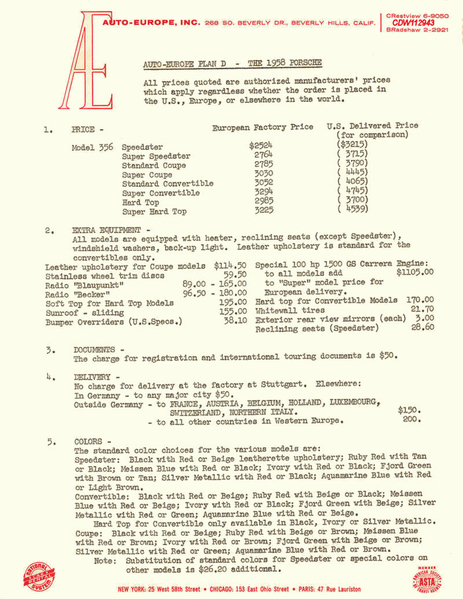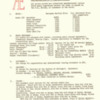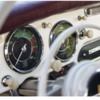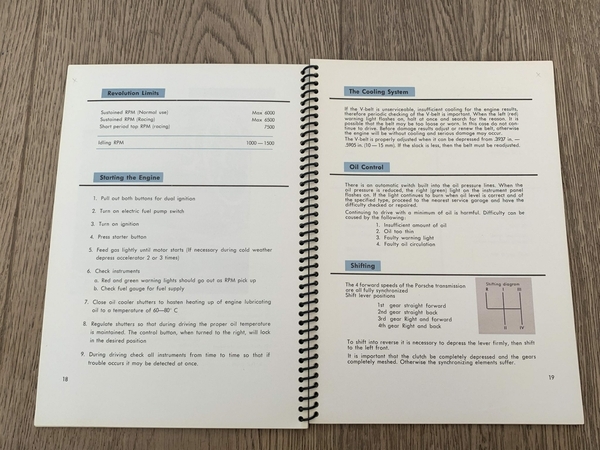I didn't know the 4-cam was an option in a 356?
Classified postings do not allow for discussion (replies are not allowed). Direct message the member if you would like to discuss the item.
The Classified section is open to any individual (non-commercial firms) posting of items for sale. Members posting commercial advertisements must be enrolled in a Supporting Merchant program.
Postings without relevant details (PRICE, location, condition, etc.) will be deleted.
Replies sorted oldest to newest
Yes it was. It was easier to take the motor out to change plugs and adjust the valves in the 356 body.
Hope whoever buys it actually drives it some. It wasn't originally intended to be an ornament.
Strange that Porsche would put that performance engine in a cabriolet 356. This mix seems a real juxtaposition of components. That engine belongs in a real speedster or a 550.
But then, I've never being a fan of how the 356 changed over the years, becoming heavier and less attractive.
At that price, and with the likelihood it will sit in protective storage, how is this car not equivalent to a non-fungible token? All but a very precious few people will actually see it in the flesh, even fewer may touch it, and who knows if anyone will actually operate it (at least as intended). It is nothing more than a set of digital photos with a clear single owner.
@Panhandle Bob posted:Hope whoever buys it actually drives it some. It wasn't originally intended to be an ornament.
It has 65,000 miles on it already. Love that it has been driven
If you desired, for a paltry $1100 (over the price of the 1600 Super engine, which was already $260 over the cost of the 1600 N in a 2500-$3,000 car) the factory would put a GS tuned 4 cam engine in any car, be it Coupe, Cabriolet or Speedster. A pretty cool option, I think!
The first price list isn't marked as to where or when but the 1300 was still available so I'm guessing that at the latest it's 1955 or '56? The 2nd is from Auto Europe (Beverly Hills, CA), 1958.
@Panhandle Bob and @WNGD- Wouldn't it be great if it was still being used as it was meant to be? Unfortunately, the mileage shown is probably from new, with who knows how few since the restoration. A car doesn't clock much going from the garage to the transport, on the the show field, back to the transport and back to the garage. It's sacrilege, when you think about it- these cars really were meant to be driven.
Attachments
At our inaugural NV750 in August 2020, someone brought their Carrera 2 to the rally. The Carrera 2's were approximately double the cost of a 1600cc 356C. The Carrera 2 engine, the type 587, was enlarged to approximately 2-litres, as opposed to the 1.5-litres of the Type 547 in the 550 Spyders.
Attachments
.
It looks like these are very good for going through tunnels.
Beyond that, I don't know about bang for the buck.
.
@ALB posted:If you desired, for a paltry $1100 (over the price of the 1600 Super engine, which was already $260 over the cost of the 1600 N in a 2500-$3,000 car) the factory would put a GS tuned 4 cam engine in any car, be it Coupe, Cabriolet or Speedster. A pretty cool option, I think!
The first price list isn't marked as to where or when but the 1300 was still available so I'm guessing that at the latest it's 1955 or '56? The 2nd is from Auto Europe (Beverly Hills, CA), 1958.
@Panhandle Bob and @WNGD- Wouldn't it be great if it was still being used as it was meant to be? Unfortunately, the mileage shown is probably from new, with who knows how few since the restoration. A car doesn't clock much going from the garage to the transport, on the the show field, back to the transport and back to the garage. It's sacrilege, when you think about it- these cars really were meant to be driven.
Adjusted for inflation, I think it’s cheaper to get the GT-3RS version of the 911 over the standard Carrera. ![]()
”Paltry” $1100 would probably get you a VW sedan back then. Our 67 was $1750 fob.
@Kevin - Bay Area posted:At our inaugural NV750 in August 2020, someone brought their Carrera 2 to the rally. The Carrera 2's were approximately double the cost of a 1600cc 356C. The Carrera 2 engine, the type 587, was enlarged to approximately 2-litres, as opposed to the 1.5-litres of the Type 547 in the 550 Spyders.
I seem to recall reading that they made a few 1300cc 547’s as well, to comply with class regs at Le Mans.
The 4-cam engine, for all the hype over the years, sounded just like all of our type 1 engines below 4,500 rpm and was available as a factory (and often as a dealer) option for those who wished to drive the price of their tiny, little German sports cars up higher than the cost of a similar year Corvette. Of course, putting that engine in, say, a 550 Spyder to annihilate said Vette happened more than once, for sure.
BUT! Get that same 4-cam up over 5 grand and into the 7K - 8K rpm range and that Banshee wail was both mesmerizing and terrorizing, especially when it went quickly past said Vette driver.
Few of us ever get to hear a 4-cam at speed on a track, these days. The last I heard one was at Lime rock Park a few years back on one of their "Historics" race days. They have a glorious, upper register sound, to be sure.
I believe that 2-liter version of the 4-cam made close to 200 horsepower. A real feat in the day.
If you have access to the latest Panorama magazine, they have a great article about a 1957 356A Carrera GT Coupe, original condition, with it's original Type 547 4 cam engine to boot. Crusty, crappy and just perfect!
110 hp @ 6400 rpm from the factory according to the article.
120 hours to assemble by an experienced tech. With timing taking as much as 8 hours.
I read the article yesterday. The engine builder took a year to complete the engine.
https://m.youtube.com/watch?v=...amp;feature=youtu.be
To hear someone who knows the four cam refer to it as “obscenely complex” made me chuckle.
@edsnova posted:I believe that 2-liter version of the 4-cam made close to 200 horsepower. A real feat in the day.
I've heard that as well, Ed. I think I remember reading that one of the last versions of the 2 liter GT dynoed at 190 hp at 7,000? 7500 rpm (maybe in a 904)? That would be a blast in a Speedster!
Does anybody know where the battery is located in a GS/GT Speedster? Between the larger gas tank and the spare tire it doesn't look like there's room for it up front... Al
These 4-cam engines were made for racing primarily, not realy for street use but hey...if you had the dough and your own 4-cam trained mechanic for tune ups, what the hey!!!
@ALB posted:I've heard that as well, Ed. I think I remember reading that one of the last versions of the 2 liter GT dynoed at 190 hp at 7,000? 7500 rpm (maybe in a 904)? That would be a blast in a Speedster!
Indeed it would. But you could have a 200hp Subie or Type4 for less than the cost of a 547 cylinder head. And it wouldn’t require a $1,000 tuneup every 10-15 hours.
Yeah. But they make great sounds and are aircooled. What could be cooler than that?
$100K in your bank account?
My best 4 cam story: Jack, the guy who owned Dean Jeffries custom Carrera, bought the car with a pushrod engine in it. When he found the history of the car he set out to find a 4 Cam for it and a buddy of his that owned 550-0113 found him 9009… for $900.
During the restoration process and prior to spending thousands on rebuilding it the owner of the original car it was in, 550-022 heard about it and offered to trade him a freshly rebuilt 547 for his original engine.
BITD, these motors were just worn out racing motors. Jack said one of the old Brumos mechanics told him he remembered taking several of them to the dump and throwing them out of the back of the truck.
Attachments
Yep. They became junk, for a while. Obsolete for racing, no good for the street. Expensive boat anchors and not really suitable even for that purpose.
One of the things that occurred to me as I put my Spyder together is that the Raby Type 1 1915 I scored from Carey, at 120 (rated) HP, is not actually similar in power an original 1500cc 547 engine, as one might at first suppose. The reason?
Torque.
The 547 was rated at about 85 ft-lbs at 5000 RPM.
My measly base 1915 makes 125 ft-lbs at 4000. That's 47 percent more grunt, 1000 RPM lower than the premier small displacement racing engine of 1955.
That's a huge difference on the street. (And of course a lot less power than those of you running 2110s, 2180s and 2332s can boast).
Frankly it's almost impossible for most of us to even imagine what a real 4-cam feels like on public roads, but it's fair to say that most of us, if we got to sample one and were being honest, would be disappointed.
Agreed. You really have to keep the 547 "on the boil" so to speak.
Not unlike Toni Zimmer's Honda S2000 I drove. About 6500-9400 is when the REAL power shows up. And when it does, it's a beautiful thing.
I've driven some older Fiat twin-cam small engines in the X19 and the Lancia Scorpion. They like to rev, but no torque.
Have you ever driven a 2.0 litre 911? Same thing, but a touch more torque because flat6.
I have another internet friend who’s probably owned 75-100 Porsches through the years, from $800 Speedsters in the early 60’s to racing 908’s, 924GT’s and Toad Hall RSRs in the 80’s-90’s. He said the same thing. The 4 Cams had a very narrow power and and were dogs below 5,000-5500 rpm. Although there was quite a premium on MSRP, many owners replaced them with pushrod motors when they needs serious repairs.
.
Yeah, not that I will ever know, but this is one of the better videos I've found of what it's like to drive one in the real world:
First take is that it seems about the same amount of grunt as my (very) mild 2-liter, except that everything happens about a grand higher. Routine shifts in traffic are at 4000 rpm. For a little more go, he shifts at 4500.
On the highway, he's doing over 4000 at 70, and I'd think the buzz would get old pretty quick on a long drive.
I can see things getting kinda nifty at, say, 7000, but you'd probably worry some about the potential expense of a missed shift.
All things considered, I'm OK with what I've got.
.
Seems like he’s barely getting on it. But then, I guess if I was a dealer driving a half million dollar car, I wouldn’t be thrashing it either. I don’t know exactly what tach shading has to do with it, but it seems like it might be pretty important considering just about every motor came with a different tach.
Carrera GS:
Attachments
The Typ 547 made its peak HP at 6200 RPM. That's only about 400-800 higher than most of our engines (mine peaks at 5500, per the dyno sheet), and Porsche had lots of technical advice for owners about how to treat/when to shift.
Boiled down: don't over-rev! Unless the other guy's in an OSCA! Achtung!
Attachments
Yeah. That was for stockers. Later on race shops shimmed the valve springs and did a little head work and they pulled to over 7k.
According to an explanation of the shaded areas I read on the 356 Register last night 7500 is “redline,” power band is 6,000-7,500, and usable power is 4,000<.
I read somewhere (here?) that under revving the 4 camers was harder on them than winding them out.
Funny thing, that’s almost exactly like my dad’s Fiat 850 Coupe. Nothing below 3600, 4K-7.5K it was a little screamer.
I know it’s apples and oranges to compare our (mostly) Brazilian repro gauges and plethora of engines to engine matched OEM Porsche tachs, but I’ve never run my motor into the red shaded area, but it’s not because it seems to be running out of grunt. In fact, compared to my Ducati engine, it feels like it’s got another K in it, easy. (Although I doubt I’ll ever tempt it.) ![]()
I hit 6500 rpm with my 2165cc, every time I drive it. Of course, after it's warmed up.
Now that I have 48mm ITBs instead of 44 IDF w/36mm chokes, it seems to want more.
Balanced internals, lightened flywheel and a decent sized cam means never having to short-shift. Wound mine to 6k today and that seems right. I set the rev limiter to 6400 just to be safe.
PS @DannyP the 2.0 flat 6 is very comparable on paper to my 1.9 Type 1. It's five horses and six ft-lbs more, both at just a couple-three hundred RPM higher.
Porsche 911T and 914’s 2.0 liter (1991cc) flat 6: 125hp @5800; 131 ft-lbs at 4200.
@edsnova posted:Balanced internals, lightened flywheel and a decent sized cam means never having to short-shift. Wound mine to 6k today and that seems right. I set the rev limiter to 6400 just to be safe.
Cummon' Eddie - that's idling with that short-throw crank!










